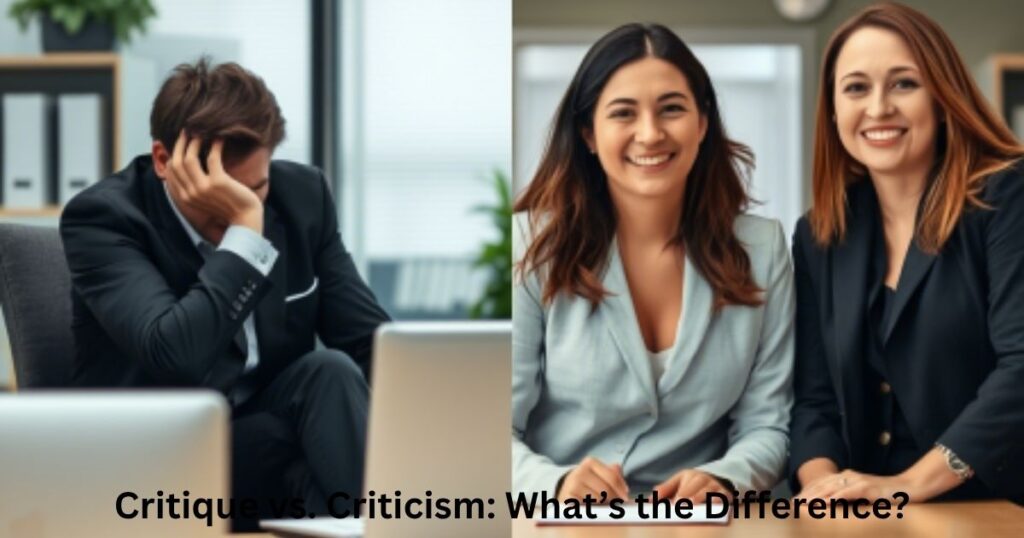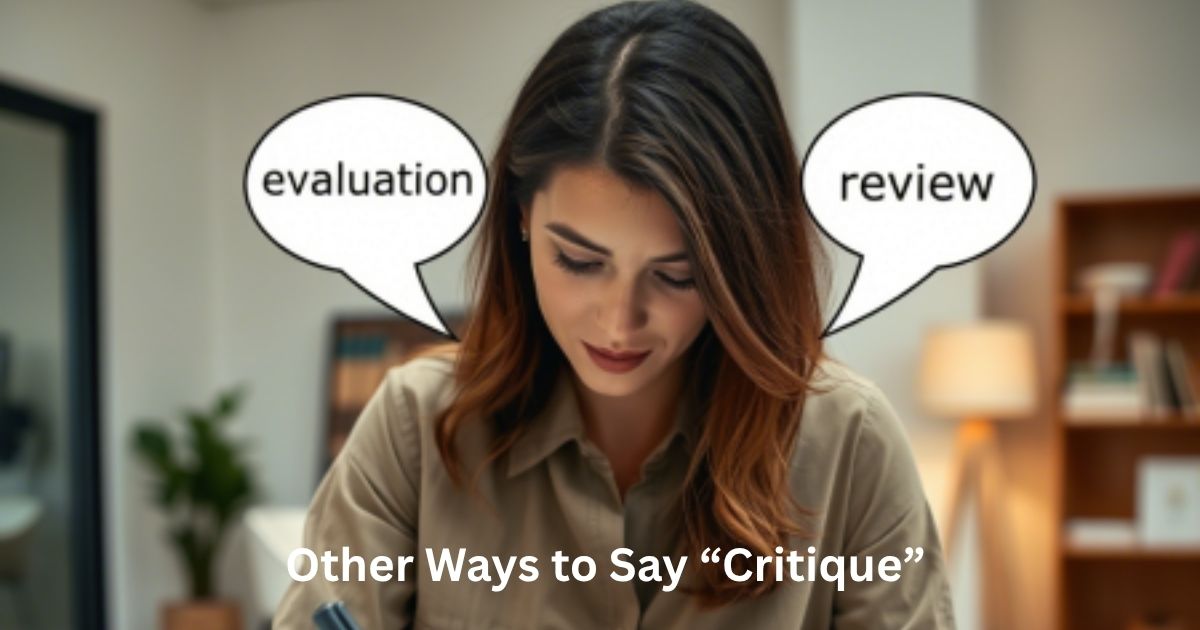In writing, art, school, or the workplace, people often share thoughts about someone else’s work. This is called a critique. It means giving honest feedback that helps improve the quality of a project, idea, or performance. A critique can highlight what is working well and what needs to change. It isn’t just about pointing out mistakes,it’s also about showing support and helping others grow. Whether you’re talking about a book, a film, a presentation, or a team effort, a well-done critique brings new understanding and better results.
Different words can be used instead of “critique,” and each offers its own tone or style. Choosing the right one makes your message clearer and more helpful. In this article, we’ll look at simple, everyday words that work just like “critique” but may suit your tone better. These words can improve how you give feedback and make communication feel more natural and thoughtful.
Main Points
When you share your opinion about something like a film, a piece of writing, or a product, you’re usually offering a critique. But using the same word every time can get boring. That’s why having different words is helpful. These words can also make your tone sound more supportive and less harsh, especially in places like a company, classroom, or creative space. If you’re giving peer feedback, writing a summary, or analyzing a project, you’ll want words that match the situation and keep things polite and easy to understand.
In the next sections, you’ll find words that fit many situations,from formal business evaluation to personal reflection. These words can help you in writing dissertations, giving performance reviews, creating editorial articles, or even talking about your favorite films. And if you’re explaining your opinion in a commentary, these words will make your message clear and kind. We’ll use simple examples and easy English, so you’ll understand each word well. These alternatives will make your communication smoother and more effective.
- A critique means giving your honest thoughts about someone’s work to help them do better.
- There are many words that mean the same as critique, like review, feedback, evaluation, and analysis.
- A review tells what is good and bad about a book, film, or product.
- An evaluation is when you check how well something works or how good it is.
- An assessment is a way to see how someone is doing on a project or task.
- Analysis means looking closely at the details to understand the big picture.
- Appraisal is often used in jobs to talk about how well a person is doing.
- Feedback helps people grow by showing what they did well and what they can improve.
- Reflection is when you think about your own work and how to make it better.
- A good critique is always kind, clear, and helpful. It helps the creator, not hurts them.
Review

The word “review” is one of the most common ways to say “critique.” You use it when you talk about what you think of a book, a film, a product, or even a service like a restaurant. People often write reviews online on websites like Amazon or Google. For example, when someone reads a novel and shares their opinion about the story, that’s a literary review. Or when you watch a movie and share what you liked or didn’t like, that’s a cinema review.
Reviews are helpful because they show both strengths and weaknesses. They usually include a short summary, some sentiment, and a clear recommendation. You’ll often see reviews used in articles, editorials, or blog posts. Whether you’re a reviewer writing for an audience or just a peer giving a quick rating, this word is friendly, easy to use, and fits most situations.
Evaluation
An evaluation is a bit more formal than a review. People use this word a lot in schools, jobs, and business meetings. For example, a supervisor might give an employee evaluation to see how well someone is doing at work. Or a teacher might give a project evaluation to help students improve. This word is great when you need to focus on performance, results, or a goal.
An evaluation often includes clear steps and uses feedback techniques to support growth. It looks at what’s working and what needs improvement. You may also hear terms like “evaluation metrics” in organizations or tech companies. This word connects to other ideas like assessment, reflection, and even summarization, and it helps create a full picture of someone’s contribution.
Assessment
An assessment is similar to an evaluation, but it can be more flexible. It can be formal, like a school test, or informal, like a peer giving you tips on your work. You might hear about formative assessments (which help during the process) or summative assessments (which happen at the end). This word is often used in schools, training programs, and creative work.
One helpful part of an assessment is that it gives you a chance to learn and grow. Whether you’re a student, an author, or a professional, it supports your development. In simple terms, it’s a good word to use when you’re trying to check the quality or progress of a task. This makes it very useful in the feedback loop where you give and receive constructive feedback.
Analysis
When you want to go deeper into something,like finding the hidden meaning in a book, breaking down a problem at work, or looking at data,you use the word analysis. This word means looking at all the parts to understand the full picture. It’s often used in academic writing, data reports, and critical analysis in literature or business.
For example, if you’re writing a dissertation or exploring a company’s marketing plan, you’d use analysis to find insights and support your points. This word connects with ideas like interpretation, insight, and understanding. It’s a great choice when you need a word that feels smart but not too difficult. It helps explain what you’re doing when you think hard about something and break it down step by step.
Appraisal
The word appraisal sounds a bit formal, but it’s useful in many settings. You’ll often hear it when talking about real estate values, employee performance, or even artistic expression. For example, a manager might give you a performance appraisal during your annual review, or a collector might offer an art appraisal to see how much a painting is worth.
Appraisals are used when you want to measure the value, effectiveness, or impact of something. They often involve a structured evaluation process, using criteria to help with decision-making. It fits well in business, education, and even personal development. Just like a critique, an appraisal shows both what’s working and what could be better.
Find more words!
There are many ways to say “critique,” and each word brings a slightly different feeling or focus. You can use tools like Merriam-Webster or Thesaurus.com to explore more words. They help you pick the right word for the right moment,whether you’re reviewing a book, writing a paper, or giving suggestions to a colleague.
Here’s a quick look at some words we’re covering: review, evaluation, assessment, analysis, appraisal, commentary, feedback, examination, inspection, judgment, rating, scrutiny, reflection, and dissection. Each one helps you say what you mean more clearly, with the right tone and context.
Commentary

Commentary is often used when people give their opinions on things like sports games, politics, or social issues. You’ll hear it in news reports, blog posts, or YouTube videos. It adds personal sentiment, style, and sometimes emotion. It’s not just about facts,it’s about your perspective and what something means to you.
You can also use interpretative commentary in writing or academic papers. This kind of commentary looks at deeper meaning, especially in literary works or artistic pieces. It makes room for your voice, and that makes your message more engaging for your audience.
Read this Also: 20 Other Ways to Say “Ability to See the Big Picture”
Feedback
Feedback is a common and friendly word used everywhere,from offices to schools to home life. When you help a friend improve a project, or a manager helps an employee, you’re giving feedback. It doesn’t have to be formal. A simple “I like this part, but maybe try this too” counts as constructive feedback.
The good thing about feedback is it encourages collaboration. Whether it’s from a peer, supervisor, or team, good feedback creates a feedback loop that leads to growth. Use it when you want to be helpful and kind while still sharing your honest thoughts.
Examination
An examination means taking a close look at something. You might do an examination of a paper, a process, or even an idea. In school, you might take a written examination. At work, someone might do a full examination of a failed project to find what went wrong.
It’s a word that shows care and attention to detail. When you take an examination, you show you’re serious about understanding the full picture. It often involves reflection, analysis, and clarification, making it perfect for critical thinking.
Inspection
Inspection means checking something carefully,usually for mistakes, problems, or safety. You often hear this word in organizations, like food safety inspections at restaurants, or project inspections before launching a product. This word shows that you’re paying close attention.
Constructive inspections don’t just look for flaws,they help people improve. If you’re in a team setting, an inspection might include helpful feedback, a shared discussion, and clear recommendations. It’s an important step in making things better.
Judgment
Judgment is a bit more personal. It often means using your experience and feelings to make a choice or share an opinion. People talk about “good judgment” or “bad judgment” in everyday conversations. It’s not always based on numbers,it’s about what feels right.
Sometimes, judgment can sound critical, so it’s best used carefully. But when used right, it can show you’ve thought deeply about something. It fits well when talking about creative work, books, or someone’s idea, and it connects closely with reflection and evaluation.
Rating
A rating is a fast and simple way to show what you think. You see ratings on apps, websites, and even in school grades. You might rate a movie 5 stars or give a product a score out of 10. It’s clear, easy to understand, and widely used in reviews and summaries.
In professional and artistic fields, ratings help people make decisions. Whether you’re a creator, a reviewer, or just a regular customer, a good rating system helps everyone know what works and what doesn’t. It gives quick insights that people trust.
Scrutiny
Scrutiny is a strong word. It means looking at something very closely,sometimes to find problems. You often hear it in serious places like courtrooms, politics, or audits. When a project or paper is under scrutiny, people are checking every detail.
Even though it sounds tough, scrutiny can lead to better work. It helps find weaknesses before they become big issues. It’s linked to analysis, examination, and judgment, and it shows that you’re serious about quality.
Reflection
Reflection means thinking quietly about something. Maybe you finished a project, and now you’re asking yourself what went well and what didn’t. Reflection is about learning from the past. It’s calm, kind, and helpful.
Writers often reflect in journals. Teachers ask students to reflect on what they learned. Reflection helps with personal growth, builds self-awareness, and improves creative work. It’s a softer way to offer a critique,one that comes from inside you.
Dissection
Dissection is a deep, careful look at something,like breaking a book into pieces to understand how it works. You might dissect a character’s actions in a literary essay, or pull apart a speech to study its language. It’s a very detailed kind of critique.
This word is perfect when you need to show every part of something. It connects with analysis, structure, interpretation, and critical thinking. Use it when you’re trying to teach or explain something clearly.
How to Give a Helpful Critique at Work

Giving a critique at work doesn’t need to be hard. Start by being kind and clear. Focus on the project, not the person. Say what worked well and where things can improve. Use easy words and stay calm.
Companies grow when people give good feedback. If your colleague finishes a presentation or a report, talk about the strengths first. Then offer ideas for changes. This keeps the team strong and helps everyone do better next time.
Critique in Everyday Conversations
You don’t need to be a writer or a critic to give a critique. We use small critiques every day. When you say, “This meal needs more salt,” that’s a simple evaluation. Or when you say, “Nice outfit, but maybe try a different color,” that’s a friendly suggestion.
In daily life, we talk about books, films, or even products we use. Giving your thoughts in a kind way helps others. Just remember to speak with care and use words that don’t sound too strong.
Using Critique to Help Creators Grow
If someone shares their art, music, or writing, they’re showing a part of themselves. A good critique helps them grow. You can say, “I loved this part, but this other part confused me.” That’s helpful and fair.
Creators need support and feedback to get better. Your words can guide their next steps. A short and honest commentary can make a big difference. Always be respectful and clear when you give your thoughts.
When to Ask for a Critique
Sometimes, you want to know what others think about your work. That’s when you ask for a critique. Maybe you wrote a book, finished a dissertation, or created a new design. Getting honest views can help you see what you missed.
You can ask a peer, supervisor, or even your team. Just say, “Can you give me your thoughts?” or “What do you think I can fix?” People often give better ideas when you ask them clearly.
Critique vs. Criticism: What’s the Difference?

A critique helps. Criticism often hurts. The two sound alike, but they’re not the same. A critique looks at both the good and the bad. Criticism only points out what’s wrong.
When you give a critique, your goal is to help someone improve. Use a soft tone. Focus on what can change, not what failed. It’s more like giving guidance, not blame. That’s how professionals, reviewers, and even teachers make a real difference.
Conclusion
The word critique is used when we talk about giving thoughts or opinions on someone’s work. A good critique helps people grow. It shows what is good and what needs to get better. People use critique in schools, jobs, and art. Writers, artists, and workers all get better from a helpful critique. It should never be mean. A kind critique makes others feel supported, not judged.
There are many ways to say critique. But no matter the word, the meaning stays the same. It is about sharing ideas in a useful way. When we give a critique, we help others do their best. We also learn by reading or hearing a critique. A strong critique is short, clear, and honest. Whether it’s a book, film, or project, a good critique brings better results. Always use critique to support, not to hurt. That’s the real power of a good critique.

Gramcoachpro is your go-to platform for mastering grammar, writing, and communication skills. If you’re a student, teacher, or content creator, we provide easy-to-understand tips, examples, and tools to improve your language — fast and effectively. Our mission is to make better writing simple and accessible for everyone.

